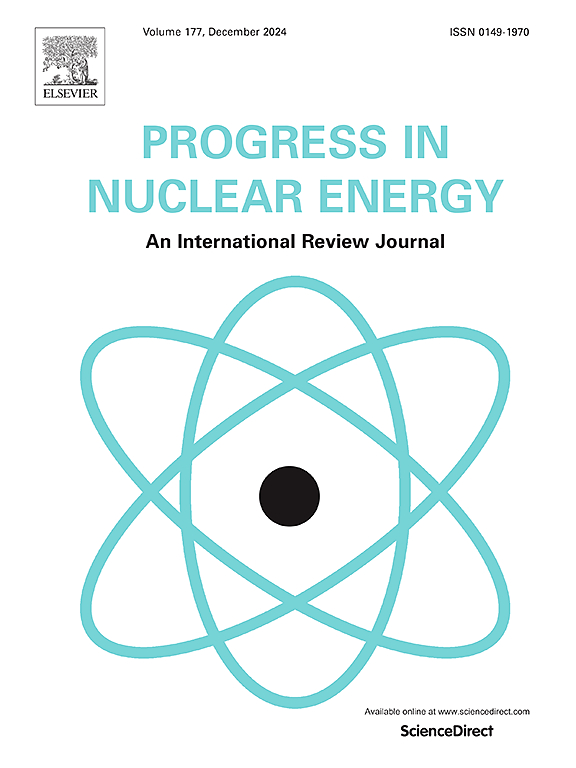Influence of healing time, technological void and temperature on the shear behavior of the GMZ bentonite healing interface
IF 3.3
3区 工程技术
Q1 NUCLEAR SCIENCE & TECHNOLOGY
引用次数: 0
Abstract
Bentonite is an engineering barrier in the deep geological repository (DGR), and its mechanical properties are negatively impacted by the presence of technological voids. Based on direct shear test and mercury intrusion porosimetry (MIP) technique, the effects of healing time, technological void and temperature on the healing interface shear behavior of Gaomiaozi (GMZ) bentonite were studied. The results indicate that the shear strength of healing interface is directly related to the dry density of the interface, which is influenced by healing time, technological void and temperature. Within the healing time range studied, as healing time increased, bentonite continued to swell, leading to a rise in the dry density of the interface and an enhancement in shear strength. During this process, constrained by the limited swelling space, the intra-aggregate porosity decreases at first and then increases until stabilizing, while the inter-aggregate porosity is on the contrary, which reduces the distance between particles, thereby increasing the cohesion and friction angle of the interface. When the initial void of the interface increases, the shear strength at the interface significantly decreases, with corresponding reductions in cohesion and friction angle. As the temperature increases, the shear strength increases, notably in cohesion, while the friction angle shows no clear pattern of change. This is primarily attributed to the rearrangement of bentonite particles, the reformation of interlayer physical and chemical bonds, and the reduced viscosity of pore fluids. The findings of this study provide important insights into the mechanical stability of engineered barriers in the DGR.
愈合时间、工艺空隙和温度对GMZ膨润土愈合界面剪切行为的影响
膨润土是深部地质资源库(DGR)的工程屏障,其力学性能受到工艺空隙的不利影响。采用直接剪切试验和压汞孔隙度测定(MIP)技术,研究了修复时间、工艺空隙和温度对高庙子膨润土愈合界面剪切行为的影响。结果表明:修复界面的抗剪强度与界面干密度直接相关,干密度受修复时间、工艺空隙和温度的影响;在研究的愈合时间范围内,随着愈合时间的增加,膨润土继续膨胀,导致界面干密度升高,抗剪强度增强。在此过程中,受有限膨胀空间的约束,团聚体内部孔隙度先减小后增大直至趋于稳定,而团聚体间孔隙度则相反,减小了颗粒之间的距离,从而增大了界面的黏聚力和摩擦角。当界面初始空隙增大时,界面处抗剪强度显著降低,黏聚力和摩擦角相应减小。随着温度的升高,抗剪强度增加,黏聚力明显增加,而摩擦角变化规律不明显。这主要是由于膨润土颗粒的重排、层间物理化学键的重组以及孔隙流体粘度的降低。本研究的发现为DGR中工程屏障的机械稳定性提供了重要的见解。
本文章由计算机程序翻译,如有差异,请以英文原文为准。
求助全文
约1分钟内获得全文
求助全文
来源期刊

Progress in Nuclear Energy
工程技术-核科学技术
CiteScore
5.30
自引率
14.80%
发文量
331
审稿时长
3.5 months
期刊介绍:
Progress in Nuclear Energy is an international review journal covering all aspects of nuclear science and engineering. In keeping with the maturity of nuclear power, articles on safety, siting and environmental problems are encouraged, as are those associated with economics and fuel management. However, basic physics and engineering will remain an important aspect of the editorial policy. Articles published are either of a review nature or present new material in more depth. They are aimed at researchers and technically-oriented managers working in the nuclear energy field.
Please note the following:
1) PNE seeks high quality research papers which are medium to long in length. Short research papers should be submitted to the journal Annals in Nuclear Energy.
2) PNE reserves the right to reject papers which are based solely on routine application of computer codes used to produce reactor designs or explain existing reactor phenomena. Such papers, although worthy, are best left as laboratory reports whereas Progress in Nuclear Energy seeks papers of originality, which are archival in nature, in the fields of mathematical and experimental nuclear technology, including fission, fusion (blanket physics, radiation damage), safety, materials aspects, economics, etc.
3) Review papers, which may occasionally be invited, are particularly sought by the journal in these fields.
 求助内容:
求助内容: 应助结果提醒方式:
应助结果提醒方式:


